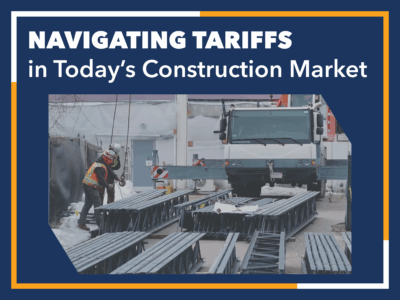
As headlines around tariffs seem to dominate the news daily, many considering construction projects have anticipated major cost escalations and widespread supply issues. While tariffs haven’t driven pricing spikes to the extent once feared, the lasting impact has been a new layer of uncertainty, affecting more than just budgets. Schedules, procurement strategies and even design decisions are all in play.
At Timberline, we recognize that we cannot control policy shifts or global logistics, but we can control how we prepare for and respond to them.
What the Market Is Telling Us
According to recent data from Engineering News-Record (ENR) and other construction cost trackers, the materials market is experiencing a steady climb in pricing across several key categories:
- Steel: ENR’s 20-city steel average rose 11.2% by the end of 2024, and mill prices climbed another 7.1% in March 2025 alone.
- Overall Materials: ENR’s national Materials Cost Index reported a 3% year-over-year increase by early 2025.
- Commodity Metals: Spot pricing shows copper up ~9%, aluminum up ~6.5%, and steel up ~12% since January – largely tied to energy costs, global demand and trade-related friction.
Though these escalations aren’t extreme, they are impactful, especially when layered onto existing pressures from labor shortages, aggressive schedules and evolving building codes.
What We’re Doing About It
At Timberline, our estimating and preconstruction teams are focused on controlling what we can. This means developing proactive strategies, being transparent with clients and partnering with subcontractors who share our commitment to risk management.
- Early Procurement & Pre-Releasing Materials
We often pre-release long-lead items, such as HVAC equipment or structural steel – and in a few instances, partial orders, or before contracts are signed. This strategy allows us to lock in pricing, reduce the chance of delay, and maintain greater control over the construction budget and schedule. - Transparent Contracts
We’ve updated our contract language to include tariff-related contingencies. This ensures upfront clarity on anticipated risks and makes it easier for owners to understand how certain materials may fluctuate. - Subcontractor Coordination & Due Diligence
Communication is key. We’re working closely with our construction partners to identify material red flags, ensure pricing is guaranteed, and verify that the legwork to source from stable supply chains has been done. With many subcontractors getting more competitive due to a softening market, it’s a strong environment for collaboration. - Material Sourcing Adjustments
We’re also actively sourcing “tariff-safe” materials and products from subcontractors and suppliers. With both our subcontractors and clients directly, we create tracking systems to evaluate costs, tariff risks and lead times. By understanding product-specific codes according to the Harmonized Tariff Schedule, we can identify risk factors depending on where items are coming from.
Pressure Points: Where We’re Seeing the Strain
The degree of tariff impact often depends on project type:
- New Construction: Structural steel, wood framing, and foundation materials are particularly vulnerable to global price swings and lead time issues.
- Renovations: Mechanical, electrical, and lighting systems – especially those manufactured abroad are at higher risk of delays or price escalation.
- Energy Code-Driven Upgrades: Massachusetts’ evolving code requirements have added cost pressure to existing building renovations. Many owners are finding it hard to justify upgrades that may trigger compliance changes they can’t afford, or don’t make economic sense, to fully implement.
Looking Ahead
Tariff uncertainty hasn’t subsided – if anything, it keeps resurfacing almost daily. This continues to challenge the industry with materials and pricing, but we’re staying ahead by locking in materials early, embedding transparency into our contracts, while maintaining close coordination with our trusted subcontractors. We have been helping clients navigate this volatility with clear plans, proactive decisions and confidence in every step forward.
Every situation is different, and more often – not as daunting as the headlines. We’re happy to help you evaluate and navigate any project pricing or budgeting you’re considering. Reach out to our Estimating & Preconstruction leaders, Karl Ginand or Tiffany Gallo, they are happy to discuss how to guide your specific construction-related questions.
